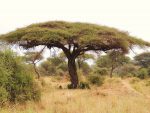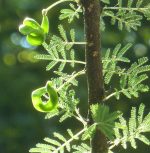 Also known as umbrella thorn and Israeli babool, this medium to large tree is native to arid and semi-arid regions of Africa but is also found in the Middle East including Israel where it grows in deserts, woodlands, and shrublands. The umbrella shaped trees may have multiple trunks and grow 13-49′ tall but may be a shrub less than 3′ under very arid condition. The stems bear two types of thorns, one long, straight, and white, the other small, hooked and brownish. The bipinnate leaves are up to 1″ long and have 4-10 pinnae, each with about 15 pairs of tiny leaflets. The sweet scented, creamy white flowers have extruded stamens and are carried in condensed, head-like spikes from late spring to early summer. The flowers give way to a flat, coiled, spring-like pod containing flat dark brown seeds. Photo Credit Wikipedia
Also known as umbrella thorn and Israeli babool, this medium to large tree is native to arid and semi-arid regions of Africa but is also found in the Middle East including Israel where it grows in deserts, woodlands, and shrublands. The umbrella shaped trees may have multiple trunks and grow 13-49′ tall but may be a shrub less than 3′ under very arid condition. The stems bear two types of thorns, one long, straight, and white, the other small, hooked and brownish. The bipinnate leaves are up to 1″ long and have 4-10 pinnae, each with about 15 pairs of tiny leaflets. The sweet scented, creamy white flowers have extruded stamens and are carried in condensed, head-like spikes from late spring to early summer. The flowers give way to a flat, coiled, spring-like pod containing flat dark brown seeds. Photo Credit Wikipedia
The Hebrew word shittah (pl. shittim) is generally thought to be a species of Acacia. There are four species of Acacia in the Bible lands and A. tortilis and A. seyal are considered the most probable species intended because of their size and suitability for use as timber. T. tortilis is the largest and most common of the two in the deserts of Arabia where the Isaelites wandered for forty years, and is especially conspicuous on Mount Sinai. The wood of twisted acacia is hard and dense, resistant to decay, and unpalatalbe to insect and is believe to have been used to build the ark of the covenant and first tabernacle. From the biblical references to acacia it appears that the wood was used for all the structural features of the tabernacle: ark and its poles, table and its poles, brazen alter and its poles, incense alter and its poles, poles and supports for the curtains. It is also interesting to notice in Exodus 25 that the Israelites were urged to bring offerings of acacia wood along with fine leather, bronze, silver, and gold.

Exodus 25:Moses receives instructions from the Lord when on the mountain for 40 days and 40 nights:
25.5 (Acceptable offerings include: ) “tanned ram skins and fine goatskin leather; acacia wood; “
25. 10 “They shall make an ark of acacia wood; it shall be two and a half cubits long, a cubit and a half wide, and a cubit and a half high. ”
25. 13 “You shall make poles of acacia wood, and overlay them with gold. “
25. 23 “You shall make a table of acacia wood, two cubits long, one cubit wide, and a cubit and a half high.”
25.28 “You shall make the poles of acacia wood, and overlay them with gold, and the table shall be carried with these .”
26. 15 “You shall make upright frames of acacia wood for the tabernacle. “
26. 26 “ You shall make bars of acacia wood, five for the frames of the one side of the tabernacle, “
26. 32 You shall hang it [curtain] on four pillars of acacia overlaid with gold, which have hooks of gold and rest on four bases of silver.
26.37 “You shall make for the screen five pillars of acacia, and overlay them with gold; their hooks shall be of gold, and you shall cast five bases of bronze for them.”
27.1 You shall make the altar [of Burnt Offereings] of acacia wood, five cubits long and five cubits wide; the altar shall be square, and it shall be three cubits high.
27.6 “You shall make poles for the altar, poles of acacia wood, and overlay them with bronze;”
30.1 “You shall make an altar on which to offer incense; you shall make it of acacia wood. “
30. 5 “You shall make the poles of acacia wood, and overlay them with gold. “
35. Moses asks for an offering of…...
35. 7 “ tanned rams’ skins, and fine leather; acacia wood, “
35.24 “ Everyone who could make an offering of silver or bronze brought it as the Lord’s offering; and everyone who possessed acacia wood of any use in the work, brought it.”
36. 20 “Then he made the upright frames for the tabernacle of acacia wood. “
36.31 “He made bars of acacia wood, five for the frames of the one side of the tabernacle, “
36.36 For it [the curtain] he made four pillars of acacia, and overlaid them with gold; their hooks were of gold, and he cast for them four bases of silver.
37.1 “Bezalel made the ark of acacia wood; it was two and a half cubits long, a cubit and a half wide, and a cubit and a half high.”
37. 4 “He made poles of acacia wood, and overlaid them with gold,
37. 10 “He also made the table of acacia wood, two cubits long, one cubit wide, and a cubit and a half high.
37.15 “He made the poles of acacia wood to carry the table, and overlaid them with gold. “
37.25 “He made the altar of incense of acacia wood, one cubit long, and one cubit wide; it was square, and was two cubits high; its horns were of one piece with it. “
37.28 “And he made the poles of acacia wood, and overlaid them with gold. “
38. 1 “He made the altar of burnt offering also of acacia wood; it was five cubits long, and five cubits wide; it was square, and three cubits high. “
38.6 “he made the poles of acacia wood, and overlaid them with bronze. “
Deuteronomy: Moses addresses the the Israelites for the last time as they prepare for their entrance into Canaan.
10.3 “So I made an ark of acacia wood, cut two tablets of stone like the former ones, and went up the mountain with the two tablets in my hand.”
Isaiah 41: God addresses the people
41. 19 “I will put in the wilderness the cedar, the acacia, the myrtle, and the olive;”
Joel 3.18 Joel describes the return of good times after the locust plague and drought.
“In that day the mountains will drip new wine, and the hills will flow with milk; all the ravines of Judah will run with water. A fountain will flow out of the LORD’s house and will water the valley of acacias.
Twisted acacia likes full sun, average to lean, dry to medium moist well-drained soil but is tolerant of less. It is subject to damage by bruchid beetle, mimosoid blights, caterpillar, termites, and grazing mammals. Propagation is by seed with concentrated suphuric acid treatment for 30minutes. The tree has been valued for the timber of its wood, and fodder for desert animals provided by its leaves, and pods. Plants are tolerant of drought, salinity, high temperatures, alkalinity, and wind and fix nitrogen in the soil so are valuable in reclaiming land in difficult sites. USDA Hardiness Zones 10-12
The genus name, Acacia, is from the Greek word akis, meaning a point or a barb and refers to the thorns. The genus name, Vachell, honors George Harvey Vachell (1789-1839) chaplain to the British East India Company in Macoa, plant collector in China. The specific epithet, raddiana, honors Giusepe Raddi (1770-1829), Italian botanist who studied the Egyptian hieroglyphs under the direction of Champollion. The specific epithet, tortilis, is the Latin word meaning twisted and refers to the shape of the p0ds.